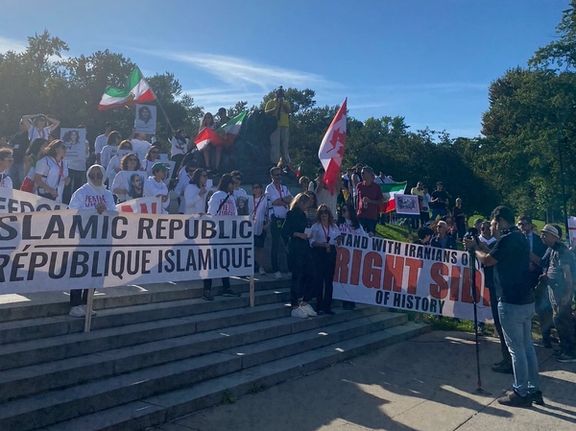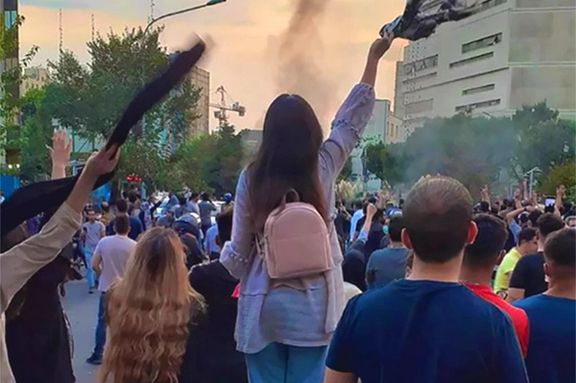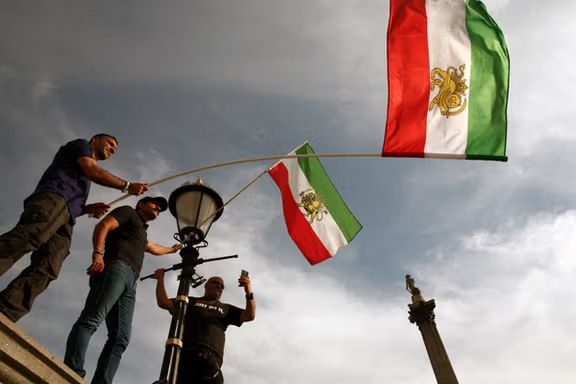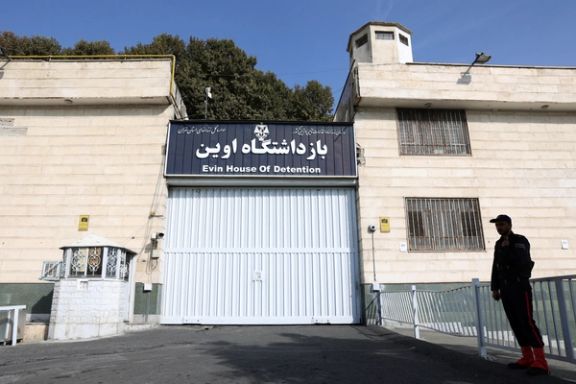Iranian-Canadians Gather For Uprising Anniversary

Iranians in Canada came together in gatherings nationwide on Saturday to mark the anniversary of the death of Mahsa Amini.

Iranians in Canada came together in gatherings nationwide on Saturday to mark the anniversary of the death of Mahsa Amini.
The events, held in multiple cities such as Toronto, Montreal and Ottawa, witnessed the participation of three Canadian ministers, highlighting their solidarity with the Iranian community and their support for human rights.

The following is a social media post by a retired member of the IRGC who fought in the Iran-Iraq war and witnessed the repressive environment in Tehran on Saturday.
-----------------------------------------------------------------------------------------------------------------------------------------------------------------
Today, Tehran is worse than the military government during the 1979 revolution.
In dealing with the people, you have outdone all the dictators in history. In 1357 [1978], I was fourteen years old, and I remember the military government in Ahvaz vividly. They would bring soldiers from their barracks and deploy them in the city. The uniformed, tired soldiers, with earth-colored uniforms and weapons in hand, had no idea why they had been brought into the city!
The most important principle of the military government was the prohibition of gatherings of more than three people during the day and a nighttime curfew. Nevertheless, religious gatherings with hundreds of attendees were held at night.
But what I witnessed today on the streets of Tehran is beyond words. I don’t exaggerate when I say that if a foreign country had occupied Tehran and Iran, they couldn't have deployed as many forces on the streets to prove that your country is occupied, and resistance is futile!

The occupier couldn't have maneuvered so many anti-riot police motorcycles through the city. The occupier couldn’t have indoctrinated so many of its troops to believe that people walking calmly, peaceful people, are the enemy!! Their outfits, what can I say? From head to toe, tightly equipped in black gear. I doubt that anywhere except in North Korea or Russia, such [repressive] gear exist.
Exactly like astronauts, like gladiators!
Of all I mentioned, what's worse and more horrifying is seeing plainclothesmen dressed in black tops and combat pants, or often jeans. They were heavily armed. With wireless devices, with electric batons and sticks. They had relatively long beards and menacing, demanding looks towards passersby, especially women. They arrested people for no reason, and they did so rudely.
A girl was walking with her male companion. They called out the man and the girl also stopped. They told her that they wanted to only question the man. But she stood there bravely. She told the agents that "we were strolling together and if we committed a crime, both of us should be arrested." They tried to intimidate her, to force her to leave. She stood there and, in the end, saved her friend in front of my surprised gaze. They left.
The police had brought so many prison busses that they could have transported tens of thousands of people. I was amazed. I often used to ask myself why our roads are so bad despite all that oil income. Why poverty wreaks havoc in the country. But today, with all the security gear I saw, I realized that this must have consumed half the oil income.
What have you done with Iran! How much seeds of hatred have you sowed? What a bunch of mercenaries you have trained. How much public money have you spent for protecting yourselves? Aren’t you ashamed? Indeed, you have outdone all dictators.
Is it possible to occupy a country in this way, especially a country with Iran’s history and civilization?
I forgot to say about brave girls who were walking in groups. Some with headscarves, some without, some with their mothers, some with their fathers, some with friends. They were so spirited, so carefree. I was trembling in fear, yet they were laughing heartily in front of the security forces. If only I could have taken a photo or a video.
Hundreds of officers in tight groups. How aggressively they warned commuters leaving the metro at Valiasr Square, shouting about their headscarves!
And what responses they got:
"It's none of your business; get lost!"
I couldn't believe my eyes! Kudos to you.
How foolish are those who think they can govern this generation with special units and the use of force! A generation that has changed significantly, far more than the authorities can imagine.
-----------------------------------------------------------------------------------------------------------------------------------------------------------------
Iran International preferred not to publish the name of the author, in order to prevent an unnecessary security risk for him. The comment was published on Telegram messaging app.

The anniversary of Mahsa Amini's, whose death birthed the biggest anti-regime protests in Iran, was marked by heavy security, sporadic rallies and a prison fire.
Since Saturday morning, social media was brimming with footage of security forces stationed at strategic spots in different cities as the regime had prepared its security forces in anticipation of protests.
Pockets of protests were reported throughout the day despite a heavy presence of regime agents, who were quick to act against any gathering that resembled the beginning of a demonstration, but as the night progressed, people started to build up confidence and pour into the streets chanting slogans against the regime.
Mahsa Amini's death anniversary, which started with the regime putting her parents under house arrest and diverting water from a nearby dam to block access to her resting place, ended with reports about a fire purportedly started by female inmates in a prison near the capital Tehran.
State media said female convicts on death row set fire to the women's ward at the Qarchak jail by burning their clothes, claiming that it was unclear if the incident was linked to the protests.
Earlier in the day, a Kurdish human rights group had reported that female inmates held protests at the prison to commemorate the anniversary. It also said special forces entered the ward, beat up the women and fired pellet bullets at some of the protesters. Moreover, detainees in the women's ward of Tehran's Evin Prison gathered in protest to mark the occasion, chanting slogans against the regime, refusing to enter their cells, and setting fire to their headscarves in the prison courtyard.
There are numerous reports of arrests of protesters and clashes between security forces and people during the day. In addition to the capital Tehran, cities of Rasht and Mashhad, which hosted President Ebrahim Raisi during the day were scenes of protests, in which people renewed their calls against the regime.
The presence of security forces was intense and access to the internet was disrupted during the day to prevent the flow of information about any unrest. However, by midnight local time people were reported to be clashing with security forces in several neighborhoods of the capital and several other cities across the country.
In Tehran and several predominantly Kurdish cities such as Kermanshah and Sanandaj, there were reports of gunshots fired at protesters. There is no immediate confirmation of possible casualties or information about the clashes.
The regime tried to portray the clashes as not related to the popular uprising, with state media claiming that the security forces foiled numerous sabotage plots. To justify the house arrest of Mahsa Amini’s father, the regime said it foiled an assassination attempt on Mahsa's father Amjad Amini.
The official IRNA news agency said the attempt on his life took place as he was on his way to visit his daughter's grave at the Aichi cemetery in the western town of Saqqez. "Security forces arrested several members of a terrorist group who wanted to assassinate Amjad Amini," IRNA said, citing the deputy governor of Kordestan province, Mehdi Ramezani.

The International Federation of Journalists (IFJ) claims at least 100 journalists have been arrested and imprisoned in Iran in the past year.
The report, published in commemoration of the one-year anniversary of the death of Mahsa Amini in custody, documented instances of press freedom violations and attacks on media professionals operating within the country.
Many of these journalists have received long sentences or were even forced to leave their jobs. Additionally, at least eight media outlets have faced restrictions due to pressure from security institutions or government and more than 20 journalists have been sentenced to prison on charges such as propaganda against the regime and acting against the country's security.
The issue of summoning whereby journalists are being ordered by judicial authorities or security forces to come for interrogations has increased dramatically in the last year, with over 110 journalists being summoned, the report claims.
At least 20 journalists have been exiled due to arrests, summons, and long-term prison sentences. To date, six journalists are still being held unfairly in prison, including Niloofar Hamedi, a journalist at Shargh newspaper, who was arrested at her home in Tehran after reporting the death of Mahsa Amini, whose death sparked the last year of protests rocking the regime.
The 20th World Press Freedom Index by Reporters Without Borders (RSF) put Iran at the rock bottom of the list earlier this year, only better than Eritrea and North Korea.
Iran ranked 178th out of 180 countries in the table, which is four places worse compared with the previous report published in 2021. In the 2022 index, even Turkmenistan, Myanmar and China rank better than the Islamic Republic.

An alliance of underground youth groups, formed during last year’s protests in Iran says it has not only endured but also expanded its efforts aimed at toppling the regime.
Speaking to Iran International, a representative of the United Youth of Iran (UYI) revealed that despite the government's repressive tactics, including widespread arrests and significant communication challenges, they have successfully broadened their efforts. Extending their outreach, they have gone beyond the alliance's initial scope, to connect with a diverse range of groups that were active during the protests. This includes workers' associations, activists, women's and student groups, as well as civil society organizations.
“This was one of our most important achievements,” the representative who requested anonymity said about UYI.
The alliance of youth groups says it fights alongside other Iranians to free the country from its repressive regime.
UYI was formed when several so-called ‘neighborhood youth groups’ found each other on social media and published a manifesto in early December, less than three months after the death of Mahsa Amini in the custody of morality police sparked several-month-long protests across Iran.
The manifesto circulated on social media said it was meant to “pave the grounds for dialogue and cooperation” among various trade organizations, unions, political groups and activists inside Iran and abroad. It has been revised several times since then.

The document said getting rid of the Islamic Republic, separation of religion and state, and the “formation of an inclusive, democratic government” formed the cornerstone of the manifesto.
“Obviously, the regime makes every effort to identify and arrest members of youth groups and clamps down on these groups to prevent them from growing. They also use tactics such as spreading rumors about our connection with dubious political groups,” the representative of UYI told Iran International.
According to her, youth groups from twenty-three cities out of the thirty-five that initially joined the alliance have persevered and remain actively engaged on the ground, consistently prepared for protests. Meanwhile, some have been forced to operate covertly due to security concerns, while others have been compromised following the arrest of their members.
“We contact each other through safe online applications such as Session and Signal but many underground activists are very weary of any contact. Some of them also have difficulty accessing the internet,” one of the leaders of the alliance who also requested anonymity told Iran International.
“The Revolutionary Guard has gained access to social media accounts of some of the original neighborhood youth groups and is controlling their accounts,” he said.
“Last year, even before Mahsa was killed, you could easily feel people’s anger on the streets, the anger coming from loss of hope in the improvement of their lives, … There was an air of darkness and misery,” Behzad, a twenty-one-year-old student of philosophy from Karaj and a member of UYI told Iran International.
According to Behzad and several other members of youth groups, Mahsa’s death sparked the protests, but it was not only vengeance that drove them to the streets to protest. People were fed up with the regime and wanted it gone, they said.
“The Islamic Republic has been dead for a long time. It has lost its legitimacy amongst the people. I’m certain that its annihilation is going to be expedited by the constant attrition among its loyal forces … People will return to the streets again, when the time comes, because we really don’t have anything to lose,” Behzad said.

“Mahsa’s killing, another example of the clerical regime’s suppression, increased people’s anger to the extent that it became explosive,” Haleh, 29, who studies arts in Esfahan (Isfahan) said.
"I joined protesters on the streets for the first time in January 2017 when the recent protest movement emerged. It was at that moment that protests in Iran transformed into a revolutionary movement due to the economic and political despair among the people," she added.
Sina, a 25-year-old studying for a master's degree in accounting in Tehran, expressed that the only conceivable future for himself and individuals in a similar situation is emigration or a transformation in the country's governance, as the current circumstances are unsustainable.
“There was this shared pain, the pain that most of the population felt … The drop in the election turnout [in 2020 and 2021] was indicative of the loss of hope in any improvement through the ballot box,” Sina said.
Arezou (27) from Nowshahr in northern Iran who holds a degree in literature also said the future looked dark and miserable to her before last year’s protests. “My country would still be sitting on the verge of an abyss even if I found a way to a bright future for myself … From economy to the environment, from politics to the society’s ethics, everything was quickly falling into decay.”
Last year’s protests spread to many large and small cities across the country, and even to some very conservative towns and villages, despite heavy-handed government crackdowns and recurring internet blackouts but gradually subsided by early 2023, when the regime took even a harsher approach and hanged two young protesters, Mohsen Shekari and Majidreza Rahnavard, in public and five others in the following months.
Around 500 were killed by security forces, tens of thousands of protesters were arrested, thousands were wounded, and hundreds lost their eyes to pellets fired directly at them by security forces during the Mahsa protests.

On the first anniversary of the death of Mahsa Amini, detainees in the women's ward of Tehran's Evin Prison gathered in protest.
Chanting slogans of dissent against the regime, the inmates took a stand by refusing to enter their cells and set fire to their headscarves in the prison courtyard.
Seven political prisoners, namely Azadeh Abedini, Sepideh Gholian, Shakila Manafzadeh, Golrokh Iraee, Narges Mohammadi, Mahboubeh Rezaei, and Vida Rabbani, jointly declared their intent to hold a sit-in within the prison courtyard.
Their motivation, they proclaimed, was to "support the people and protest against the regime." This symbolic gesture served as a poignant denunciation of what they termed the "tyranny of the religious authoritarian regime," with the protest occurring on the day when Mahsa Amini lost her life under the pretext of compulsory hijab.
In a statement conveyed via Narges Mohammadi's Instagram page on Friday, the group called upon the people of Iran and the global community to amplify the voices of dissent and opposition, emphasizing the importance of standing united against injustice.
In a demonstration of solidarity with the ongoing protests, a number of other political detainees embarked on a hunger strike. Ali Younesi, Mostafa Tajzadeh, Saeed Madani, Hossein Razzagh, Mehdi Mahmoudian, and Mohammad Najafi issued a letter from Evin Prison, announcing their decision to initiate a hunger strike on Saturday.
In the days preceding the anniversary of Mahsa Amini's death, numerous calls for a nationwide strike and demonstrations, both within Iran and across international cities, have gained momentum.
The Canadian foreign minister, Melanie Joly, participated in a demonstration in Montreal and expressed "unwavering support" for the "Women's Movement in Iran" through a tweet. "We will continue to sanction even the most senior leaders of the Iranian regime and work to recognize the regime for what it is— one that spreads terror," she said.
As of this weekend, Canada has sanctioned 176 Iranian individuals and 192 Iranian entities, including the IRGC and key members of the regime’s security, intelligence and economic apparatuses. Since October 2022, Canada has sanctioned 31 entities and 135 individuals.
Accompanying the Iranian community, Jenna Sudds, Minister of Family, Children, and Social Development, and Marc Miller, Minister of Immigration, Refugees, and Citizenship of Canada, also joined gatherings in Ottawa, where they delivered speeches to show their solidarity.
There are over 200,000 Iranian-born Canadians in the country, a large number of those emigrating since 2011.






